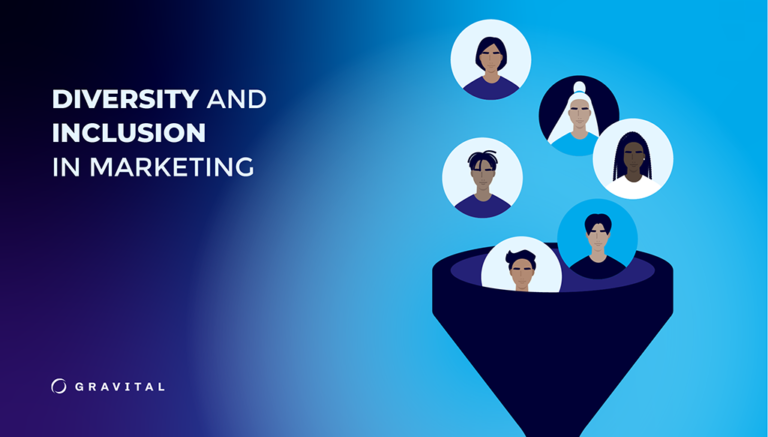The concept of diversity and inclusion has steadily grown into a pillar of modern marketing, propelled into the mainstream by a deeper understanding of the varied tapestry of global consumer markets.
In the past decade, we’ve seen a significant increase in the representation of diverse groups in ad campaigns. Prioritizing diversity and inclusion is no longer just a matter of ethical obligation or social responsibility but also a strategic component in the marketing toolkit. For brands and marketers, it’s crucial to recognize that their audience is not a monolith but a rich mosaic of cultures, identities and experiences.
As we delve deeper into this subject, we’ll explore how diversity and inclusion are defining elements in the relationship between brands and audiences.
Diversity and Inclusion Defined
Diversity refers to the representation of different groups of people, including but not limited to race, ethnicity, age, gender, sexual orientation, religion and ability in marketing campaigns.
Inclusion goes a step further. It involves creating marketing content that not only represents diverse groups but also reflects a variety of experiences, preferences and needs. Inclusion amplifies marginalized voices, celebrates unique perspectives and creates a space where everyone can feel heard, valued and empowered.
Dove’s “Real Beauty” campaign shattered traditional beauty standards by featuring women of diverse body types, ethnicities and ages. Similarly, Nike’s “Dream Crazier” celebrated female athletes and challenged gender stereotypes. These campaigns resonated deeply with audiences because they transcended superficial messaging and tapped into the core values of inclusivity and empowerment.
The Case for Diversity and Inclusion in Marketing
Embracing diversity and inclusion in marketing is not merely a trend; it’s a strategy that yields tangible benefits. Studies have consistently demonstrated a positive correlation between these principles and higher brand loyalty, market share and profitability. Consumers, particularly younger generations, are increasingly drawn to brands that authentically reflect the diversity of the world around them.


Following are some of the benefits of incorporating diversity and inclusion in marketing campaigns:
- Broader Market Reach: Diverse and inclusive marketing lead to broader appeal, allowing brands to connect with a wider audience. For example, a beauty brand that showcases a diverse range of skin tones in its products and marketing campaigns is likely to attract a more diverse customer base.
- Enhanced Brand Reputation: Brands that actively promote diversity and inclusion are often viewed more favorably by consumers. This positive brand perception can lead to increased loyalty and customer trust.
- Reflecting Real-World Demographics: As global demographics continue to evolve, marketing strategies that embrace diversity and inclusion are more reflective of the real world, making them more authentic and relatable.
- Innovation and Creativity: Diverse perspectives lead to more creative and innovative marketing ideas. Teams that are diverse in terms of backgrounds and experiences are more likely to come up with unique marketing solutions.
READ ALSO: AI IN MARKETING: 11 WAYS TO TAKE YOUR BUSINESS FROM ZERO TO HERO
How To Incorporate Diversity and Inclusion in Your Marketing Campaigns
Here are a few tips for integrating inclusion and diversity into your marketing efforts:
1. Conduct Thorough Market Research
Understand the composition, diverse needs and preferences of your audience. This process involves demographic, psychographic and cultural research to identify the diverse groups within your target market.
2. Build a Diverse Team
Assemble a marketing team that includes members from diverse backgrounds to encourage a variety of perspectives during campaign development. The more diverse your team is, the more inclusive your marketing strategies will be.
3. Authentic Representation
Avoid stereotypes in your marketing. Representations of different groups should be respectful, accurate and authentic.
4. Go Beyond Demographics
Consider factors such as socioeconomic status, ability and cultural perspectives.
5. Use Inclusive Language and Imagery
Use language (such as gender-neutral language) and imagery in your marketing materials that reflect diversity and inclusion.


6. Provide Accessible Content
Design marketing materials that are accessible to everyone, including people with disabilities. Accessibility includes voice access, closed captions in videos, and alternative text for images, among others.
7. Partner With Diverse Content Creators and Influencers
Collaborate with individuals who can authentically represent your target demographics. Consider working with influencers from various backgrounds to extend your reach to different communities.
8. Pursue Knowledge and Improvement
Seek feedback about your marketing campaigns from diverse groups and be willing to make changes based on this feedback. Stay informed about cultural trends and sensitivities to avoid missteps.
Final Words
Practicing diversity and inclusion in marketing is not just a moral imperative but a business necessity. It enhances audience engagement, brand reputation, creativity and innovation, brand trust and loyalty, and ensures that marketing campaigns resonate with a broad spectrum of consumers. By embedding these principles into your marketing strategies, you can create more relevant and successful campaigns.
If you would like to boost diversity and inclusion in your marketing efforts, talk to us.


